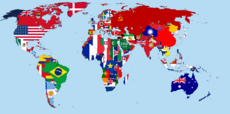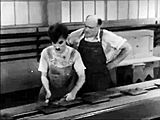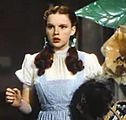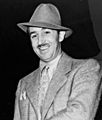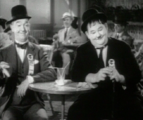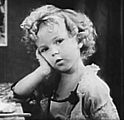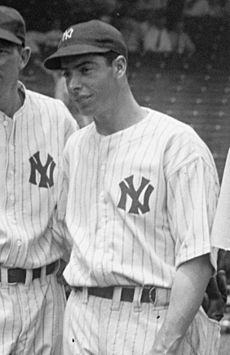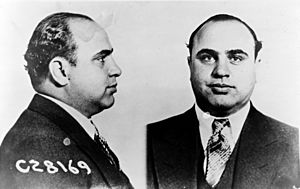1930s facts for kids
The 1930s (also called "the '30s" or "the Thirties") was a ten-year period that started on January 1, 1930, and ended on December 31, 1939. In the United States, this time was often called the "Dirty Thirties" because of the Dust Bowl.
This decade was a time of big economic and political problems around the world. These problems eventually led to World War II.
Contents
- Global Conflicts: Wars of the 1930s
- Economic Challenges: The Great Depression
- Innovations: Science and Technology
- Culture and Entertainment
- Famous People of the 1930s
- See also
Global Conflicts: Wars of the 1930s
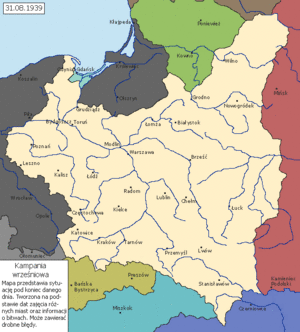
The 1930s saw several wars break out in different parts of the world:
- Colombia–Peru War (1932–1933) – A conflict between Colombia and Peru.
- Chaco War (1932–1935) – Fought between Bolivia and Paraguay over land called Gran Chaco. Paraguay won this war.
- Saudi–Yemeni War (1934) – A short war between Saudi Arabia and the Mutawakkilite Kingdom of Yemen.
- Second Italo-Ethiopian War (1935–1937) – Italy invaded Ethiopia.
- Second Sino-Japanese War (1937–1945) – A major war between China and Empire of Japan. This was the biggest war in Asia during the 20th century.
- World War II (1939–1945) – This huge global war began in Europe and the Pacific. It involved most countries, including all the major powers like Germany, Russia, America, Italy, Japan, France, and the United Kingdom.
Economic Challenges: The Great Depression
The 1930s were largely defined by the Great Depression. This worldwide economic downturn started with the stock market crash in October 1929.
- The decade was marked by very high unemployment and widespread poverty.
- Prices for goods and services actually fell during parts of the 1930s.
- Governments started to get more involved in the economy to try and fix the problems. New ideas like Keynesianism became popular.
- In the U.S., the government created work programs to help people find jobs. The Civilian Conservation Corps (CCC) hired people to work on national parks and build roads.
- Big projects like the Hoover Dam were built between 1931 and 1936, providing many jobs.
- The Soviet Union also saw fast growth in its industries.
- Prohibition, which banned alcohol in the U.S., ended in 1933.
- Severe droughts in states like Oklahoma and Texas caused the Dust Bowl. This natural disaster forced thousands of families to leave their farms and look for work elsewhere.
Innovations: Science and Technology
The 1930s brought many exciting new inventions and discoveries.
New Technologies of the 1930s
- In 1930, the first frozen foods were sold by Clarence Birdseye.
- Nestlé created the first white chocolate candy, the Milkybar.
- The first color sound cartoon, "Fiddlesticks", was made in 1930.
- Warner Brothers released the first full-color, wide-screen movie, "Song of the Flame", in 1930.
- Air mail service began flying across the Atlantic Ocean.
- Radar was invented, which helped detect objects using radio waves.
- 3M started selling Scotch Tape in 1933.
- RCA Victor introduced the first long-playing phonograph record in 1931.
- The A4 Pacific steam locomotive was introduced in 1935. One of these, the Mallard, became the fastest steam train in the world in 1938.
- Kodachrome, the first color film, was invented in 1935 by Eastman Kodak.
- The BBC started the first regular high-definition television broadcasts in 1936.
- Nuclear fission, a process that splits atoms, was discovered in 1939.
- The Volkswagen Beetle, a very popular car, was designed in the late 1930s.
- Howard Hughes set new airspeed records in his H-1 plane in 1935 and 1937.
- The first commercial airline flights between continents began.
- The chocolate chip cookie was invented in 1938 by Ruth Graves Wakefield.
- The "Frying Pan" became the first electric lap steel guitar.
- Edwin Armstrong invented wide-band frequency modulation radio in 1933.
- The bass guitar was invented in 1936.
Scientific Discoveries

- Astronomer Clyde Tombaugh discovered Pluto in 1930. It was announced as the ninth planet in our Solar System at the time.
- Albert Einstein's scientific work helped lay the groundwork for understanding atomic energy.
Culture and Entertainment
The 1930s were a vibrant time for arts and entertainment, even with the economic challenges.
Books and Art
- The Art Deco style was very popular in North America and Europe.
- Many famous books were published, including:
* Tender Is the Night (1934) by F. Scott Fitzgerald * The Hobbit (1937) by J. R. R. Tolkien * Brave New World (1932) by Aldous Huxley * The Grapes of Wrath (1939) and Of Mice and Men (1937) by John Steinbeck * Gone with the Wind (1936) by Margaret Mitchell, which later became a famous movie.
- "Hardboiled" crime stories became popular, featuring detectives like those in The Big Sleep and The Maltese Falcon.
- Two of the most famous superheroes, Superman (1938) and Batman (1939), first appeared in comic books.
- Popular comic strips that started in the 1930s included Flash Gordon and Prince Valiant.
Best-Selling Books in the U.S.
- 1930: Cimarron by Edna Ferber
- 1931: The Good Earth by Pearl S. Buck
- 1932: The Good Earth by Pearl S. Buck
- 1933: Anthony Adverse by Hervey Allen
- 1934: Anthony Adverse by Hervey Allen
- 1935: Green Light by Lloyd C. Douglas
- 1936: Gone with the Wind by Margaret Mitchell
- 1937: Gone with the Wind by Margaret Mitchell
- 1938: The Yearling by Marjorie Kinnan Rawlings
- 1939: The Grapes of Wrath by John Steinbeck
Movies: The Golden Age of Hollywood
The 1930s were a special time for movies, often called the Golden Age of Hollywood.
- Charlie Chaplin's famous silent film "City Lights" was released in 1931. His last film as "The Tramp" character, "Modern Times", came out in 1936.
- Walt Disney's first full-length animated movie, Snow White and the Seven Dwarfs, was released in 1937.
- Two iconic movies, The Wizard of Oz and Gone With The Wind, both came out in 1939.
- With new sound and color technologies, many classic films were made.
- Universal Pictures started making its famous horror films, known as the Universal Monsters. These included Dracula, Frankenstein, and King Kong. These movies made stars like Bela Lugosi and Boris Karloff famous.
- Popular film series featured groups like The Three Stooges, Laurel and Hardy, and the Marx Brothers.
- In 1930, Howard Hughes produced Hell's Angels, which was the most expensive movie ever made at the time.
-
Charlie Chaplin in a scene from the film Modern Times (1936)
-
Judy Garland as Dorothy Gale in The Wizard of Oz (1939)
-
Albert Einstein with Charlie Chaplin at the premiere of "City Lights" (1931)
Radio: A New Way to Connect
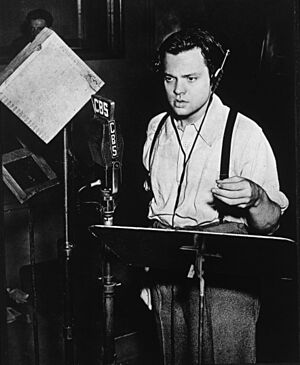
- Radio became the most important way for people to get news and listen to music in many countries.
- A famous event happened on October 30, 1938, when Orson Welles broadcast his radio play of The War of the Worlds. Some listeners thought it was real news about an alien invasion, causing panic.
Music: The Rise of Swing
- "Swing" music became very popular starting in 1933, leading to the "Swing era." It replaced earlier forms of Jazz.
- "Delta Blues" music grew with artists like Robert Johnson.
- Django Reinhardt and Stéphane Grappelli helped create Gypsy jazz.
- Charlie Christian was the first electric guitarist to play in a mixed-race band in 1939.
Popular Songs of the 1930s
- 1930: "Body and Soul"
- 1931: "Life Is Just a Bowl of Cherries"
- 1932: "Night and Day"
- 1933: "It’s Only a Paper Moon"
- 1934: "Blue Moon"
- 1935: "Begin the Beguine"
- 1936: "I'm an Old Cowhand"
- 1937: "A Foggy Day"
- 1938: "Chiquita Banana"
- 1939: "All the Things You Are"
Fashion: Shoulders and New Fabrics
Fashion in the 1930s focused on wider shoulders for both men and women.
- New man-made fabrics like rayon and nylon became widely used for clothes and stockings.
- The zipper became a common feature in clothing.
- Getting a suntan became fashionable, leading to new types of beachwear.
- Designer Madeleine Vionnet became famous for her "bias-cut" dresses, which draped beautifully on the body.
- Fashion trendsetters included royalty like The Prince of Wales and Hollywood movie stars such as Fred Astaire and Carole Lombard.
Architecture: Tall Buildings and Bridges
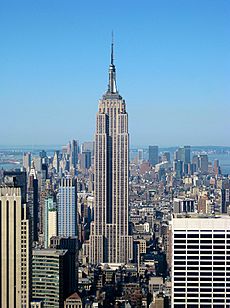
- The Empire State Building opened in New York City in 1931. It was the world's tallest building for the next 35 years.
- The Golden Gate Bridge in San Francisco, USA, was completed and opened in 1937.
Visual Arts: Capturing Reality
Social realism was an important art movement during the Great Depression in the United States. Artists often showed images with social or political messages.
- Photography played a big role in the Social Realist movement. Photographers like Dorothea Lange and Walker Evans captured powerful images of everyday life during the Depression.
- The U.S. government's New Deal programs, like the Federal Art Project, hired many American artists to help them earn a living.
- Mexican muralism was a strong art movement in Mexico, often showing political and social themes.
- In Europe, art movements like Surrealism and Cubism continued to be popular.
Sports: Olympic Games and World Cups
The 1930s hosted several major international sporting events.
- The 1932 Winter Olympics were held in Lake Placid, New York, USA.
- The 1932 Summer Olympics were held in Los Angeles, California, USA.
- Italy hosted and won the 1934 FIFA World Cup.
- Germany hosted the 1936 Winter Olympics and 1936 Summer Olympics. These were the last Olympic Games until 1948.
- France hosted the 1938 FIFA World Cup, which Italy also won. This was the last FIFA World Cup until 1950.
Famous People of the 1930s
Many individuals became well-known during this decade.
Actors and Entertainers
-
Laurel & Hardy in their film "The Flying Deuces" (1939)
-
Shirley Temple, 1933
-
The Marx Brothers, 1931
-
Clark Gable as Rhett Butler in the trailer for Gone with the Wind (1939)
Filmmakers
Musicians
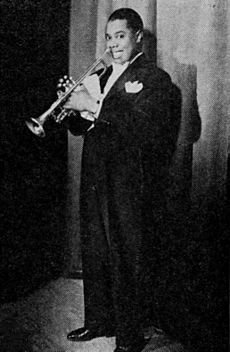
Influential Artists
Photography
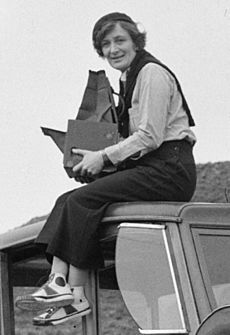
Sports Figures

- Donald Bradman (cricketer)
- Fred Perry (tennis)
- Joe Louis (boxing)
- Don Budge (tennis)
- Joe DiMaggio (baseball)
- Lou Gehrig (baseball)
- Bobby Jones (golf)
- Jesse Owens (sprinter)
- Babe Ruth (baseball)
Well-known Figures
Some individuals became known during the Great Depression:
- Al Capone
- Bonnie and Clyde
- John Dillinger
See also
 In Spanish: Años 1930 para niños
In Spanish: Años 1930 para niños
Timeline
You can find more details about the 1930s in these yearly timelines:


